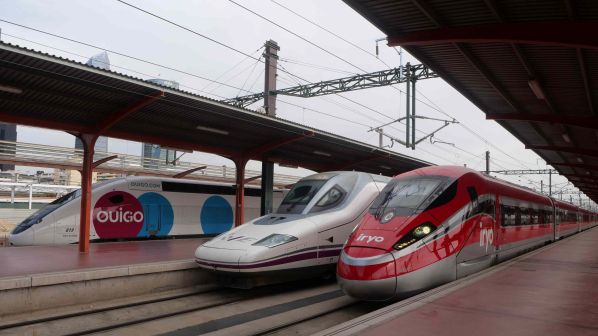AS an established retailer of travel passes, rail tickets and other products for journeys within Europe, Rail Europe is well placed to assess how demand is evolving after the Covid-19 pandemic, particularly among its traditional customer base of passengers from outside Europe.
The company’s CEO, Mr Björn Bender, reports overall demand between 22% and 23% higher than in 2019 before the pandemic, noting strong demand for cross-border services and the increasing public appetite for overnight trains. Here, the picture has “completely changed,” he says. After many years of decline, new entrants are now seeking to meet this growing demand, while among the incumbents Austrian Federal Railways (ÖBB) is notably investing in new rolling stock and growing the Nightjet network.
Speaking to IRJ at the end of November last year, Bender reported that sales at Rail Europe up to that point in 2023 were 60% ahead of 2022, “which is incredibly high for us,” he noted. “People from outside Europe are travelling again to Europe and within it,” he says.
The fall in commuter traffic that many operators in Europe have experienced as working patterns change “is good for us as it is not our customer base,” Bender says. In the leisure market that forms the bulk of Rail Europe’s business, he notes the trend for people to make more leisure trips and take more short breaks, such as over a long weekend, rather than one single major holiday every year.
As well as being seen as a more environmentally-friendly option by the travelling public, rail is currently enjoying a positive political environment in Europe. “Modal shift to rail is heavily supported by governments and the European Commission,” Bender notes. And as the European passenger market increasingly opens up to competition, new operators are emerging which can present problems for passengers looking to find the best deal.

Bender points to Italy, and particularly Spain, where the incumbent Renfe is now competing for high-speed business with Iryo and Ouigo, and has set up its own low-cost operation, Avlo. “This was not the case five or 10 years ago,” Bender says. “You cannot rely on a single state-owned operator anymore.”
Rail Europe currently sells some 5 million tickets a year and offers a range of passes and other products for travel with 200 operators in Europe. “New fares, products and operators are being added every week,” Bender says. He sees a clear need for “agnostic players” enabling passengers to compare fares and train times, believing that rail is 10, 15 or even 20 years behind the air travel market in this respect. “Customers are getting more and more used to using neutral platforms like Skyscanner,” he says.
“People are looking for neutral players… enabling them to compare prices, routes and timetables on a transparent basis,” Bender says, taking as an example a cross-border journey between France and Germany. “Sometimes you pay a different price for the same seat on the same train at the same time, depending on which website you use to make your booking.”
Price comparison
Customers can now compare prices and times using the Rail Europe’s own website, and on November 23 the company announced the addition of the Multi-Providers feature to its range of online channels for travel agents. This enables them to compare options for journeys such as London - Berlin that previously had to be split into their constituent legs, and provides booking, ticketing, payment and after-sales all in one place.
“Not every travel agent has to be a rail expert anymore,” says Bender. The new system still has some black holes such as eastern Europe and the Nordic countries, he says, and Rail Europe is working to fill these soon.
Multi-Providers is available on all of Rail Europe’s B2B channels for travel agents, which include RailAPI that it describes as a robust, real-time synchronisation tool providing businesses with direct access to the Rail Europe database, well suited for customers requiring deep integration and customisation. RailAPI feeds data in real time to websites like Expedia, and suits larger companies with their own IT resources as it can take three to four months to install.
More suited to medium-sized companies is RailFlash, launched at World Travel Market London on November 7, which provides lightweight connectivity without the need for comprehensive integration. Rail Europe says that this “really innovative” system has been designed with simplicity, efficiency and speed in mind, enabling its travel agent partners to “get up and running in no time.”
Also aiming to provide access to the Rail Europe product range with minimal set-up is RailPortal, an off-the-shelf trade website solution that features a pre-designed, user-friendly interface. The simplest connectivity solution for travel agents is RailLink, aimed at businesses looking to establish an affiliation with Rail Europe and earn commission without the complexities of deeper integration.
Data and cooperation
Rail Europe’s current strategy is based on “lots of investment,” Bender says, especially in technology as shown by the roll-out of these new products aimed at making rail bookings easier for travel agents, and for the increasing number of passengers wanting to make their own bookings using websites such as Rail Europe’s own. Bender says that as a 100% privately-owned company, Rail Europe has made a “strategic decision” to focus on customers within Europe itself. “We’re going where the demand is highest,” he says.
The company is investing internally in new tools and processes, as it seeks to gather more insights from its own data. “We are specifically interested in where our clients are travelling to, what type of train they are using and for what purpose, such as business or leisure,” Bender says. “We are also seeing demand for a high level of service, where the customer is accompanied at every stage of the journey, from planning to execution,” he adds, saying that he is “completely convinced” that the rail sector can do much better in this field. AI and NFC technology may provide a solution.
“For rail data we are still dependent on the operators, and that is definitely a pain point as there is no standardisation in Europe.”
Mr Björn Bender, Rail Europe CEO
To provide its customers with a wide range of journey options and ticketing products, Rail Europe deals with a large amount of third-party data. “For rail data we are still dependent on the operators, and that is definitely a pain point as there is no standardisation in Europe, but it is getting better,” he says. “We rely on operator data as the broker in the middle.”
Rail Europe is lobbying for standardisation, and welcomes initiatives such as the EC’s proposed Multi-Modal Digital Mobility Services directive. “It’s going in the right direction,” Bender says, while noting that the debate over the need for greater standardisation in rail data “has been going on for decades.”
Rail Europe does not see itself as competing with the incumbent national operators in Europe. “We see the incumbents as our partners,” Bender says, pointing out that Rail Europe relies on them to provide data.
With Rail Europe handling sales to customers outside their home markets, “they are freed up to focus on their national markets.”
“Cross-border is a low priority for them,” Bender says. “They understand we are really not competing, bringing more customers and more revenue. Public-private partnerships will make the difference.” He cites German Rail (DB) as one incumbent that has recognised the additional value that Rail Europe can bring, helping to grow its passenger business.
For Bender, the target in the European Union’s Smart and Sustainable Mobility Strategy to double high-speed traffic by 2030, now only six years away, will be “almost impossible” to achieve, given the limitations of both infrastructure and rolling stock. “To double ridership, operators need to have a strong partner,” he says, noting that Rail Europe is even-handed in its approach to incumbents and to their new competitors entering the market. “We don’t differentiate between state-owned operators and private companies,” Bender says. “We are collaborating on the same level with both.”

